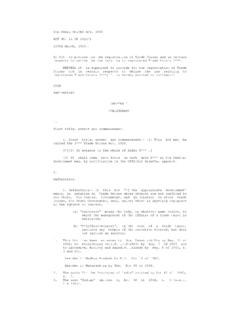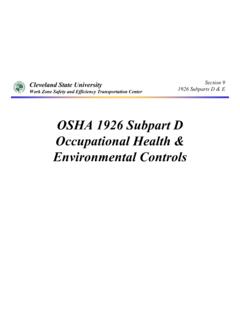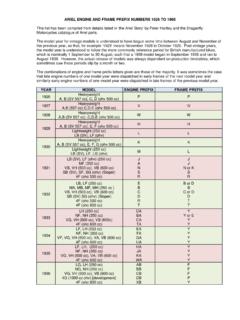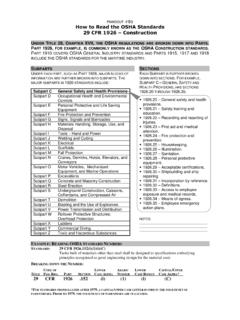Transcription of Subpart AA Confined Spaces in Construction
1 Subpart AA Confined Spaces in Construction Reserved Scope Definitions General requirements Permit-required Confined space program Permitting process Entry permit Training Duties of authorized entrants Duties of attendants Duties of entry supervisors Rescue and emergency services Employee participation Provision of documents to Secretary Authority: 40 3701 et seq.; 29 653, 655, 657; Secretary of Labor s Order No. 1-2012 (77 FR 3912); and 29 CFR Part 1911. Scope. (a) This standard sets forth requirements for practices and procedures to protect employees engaged in Construction activities at a worksite with one or more Confined Spaces , subject to the exceptions in paragraph (b) of this section. Note to paragraph (a). Examples of locations where Confined Spaces may occur include, but are not limited to, the following: Bins; boilers; pits (such as elevator, escalator, pump, valve or other equipment); manholes (such as sewer, storm drain, electrical, communication, or other utility); tanks (such as fuel, chemical, water, or other liquid, solid or gas); incinerators; scrubbers; concrete pier columns; sewers; transformer vaults; heating, ventilation, and air-conditioning (HVAC) ducts; storm drains; water mains; precast concrete and other pre-formed manhole units; drilled shafts; enclosed beams; vessels; digesters; lift stations; cesspools; silos; air receivers; sludge gates; air preheaters; step up transformers; turbines; chillers; bag houses; and/or mixers/reactors.
2 (b) Exceptions. This standard does not apply to: (1) Construction work regulated by 1926 Subpart P Excavations. (2) Construction work regulated by 1926 Subpart S Underground Construction , Caissons, Cofferdams and Compressed Air. (3) Construction work regulated by 1926 Subpart Y Diving. (c) Where this standard applies and there is a provision that addresses a Confined space hazard in another applicable OSHA standard, the employer must comply with both that requirement and the applicable provisions of this standard. 2 Definitions. The following terms are defined for the purposes of this Subpart only: Acceptable entry conditions means the conditions that must exist in a permit space , before an employee may enter that space , to ensure that employees can safely enter into, and safely work within, the space . Attendant means an individual stationed outside one or more permit Spaces who assesses the status of authorized entrants and who must perform the duties specified in Authorized entrant means an employee who is authorized by the entry supervisor to enter a permit space .
3 Barrier means a physical obstruction that blocks or limits access. Blanking or blinding means the absolute closure of a pipe, line, or duct by the fastening of a solid plate (such as a spectacle blind or a skillet blind) that completely covers the bore and that is capable of withstanding the maximum pressure of the pipe, line, or duct with no leakage beyond the plate. Competent person means one who is capable of identifying existing and predictable hazards in the surroundings or working conditions which are unsanitary, hazardous, or dangerous to employees, and who has the authorization to take prompt corrective measures to eliminate them. Confined space means a space that: (1) Is large enough and so configured that an employee can bodily enter it; (2) Has limited or restricted means for entry and exit; and (3) Is not designed for continuous employee occupancy. Control means the action taken to reduce the level of any hazard inside a Confined space using engineering methods (for example, by ventilation), and then using these methods to maintain the reduced hazard level.
4 Control also refers to the engineering methods used for this purpose. Personal protective equipment is not a control. Controlling Contractor is the employer that has overall responsibility for Construction at the worksite. 3 Note. If the controlling contractor owns or manages the property, then it is both a controlling employer and a host employer. Double block and bleed means the closure of a line, duct, or pipe by closing and locking or tagging two in-line valves and by opening and locking or tagging a drain or vent valve in the line between the two closed valves. Early-warning system means the method used to alert authorized entrants and attendants that an engulfment hazard may be developing. Examples of early-warning systems include, but are not limited to: alarms activated by remote sensors; and lookouts with equipment for immediately communicating with the authorized entrants and attendants. Emergency means any occurrence (including any failure of power, hazard control or monitoring equipment) or event, internal or external, to the permit space that could endanger entrants.
5 Engulfment means the surrounding and effective capture of a person by a liquid or finely divided (flowable) solid substance that can be aspirated to cause death by filling or plugging the respiratory system or that can exert enough force on the body to cause death by strangulation, constriction, crushing, or suffocation. Entry means the action by which any part of a person passes through an opening into a permit-required Confined space . Entry includes ensuing work activities in that space and is considered to have occurred as soon as any part of the entrant s body breaks the plane of an opening into the space , whether or not such action is intentional or any work activities are actually performed in the space . Entry Employer means any employer who decides that an employee it directs will enter a permit space . Note. An employer cannot avoid the duties of the standard merely by refusing to decide whether its employees will enter a permit space , and OSHA will consider the failure to so decide to be an implicit decision to allow employees to enter those Spaces if they are working in the proximity of the space .
6 Entry permit (permit) means the written or printed document that is provided by the employer who designated the space a permit space to allow and control entry into a permit space and that contains the information specified in of this standard. Entry rescue occurs when a rescue service enters a permit space to rescue one or more employees. 4 Entry supervisor means the qualified person (such as the employer, foreman, or crew chief) responsible for determining if acceptable entry conditions are present at a permit space where entry is planned, for authorizing entry and overseeing entry operations, and for terminating entry as required by this standard. Note. An entry supervisor also may serve as an attendant or as an authorized entrant, as long as that person is trained and equipped as required by this standard for each role he or she fills. Also, the duties of entry supervisor may be passed from one individual to another during the course of an entry operation. Hazard means a physical hazard or hazardous atmosphere.
7 See definitions below. Hazardous atmosphere means an atmosphere that may expose employees to the risk of death, incapacitation, impairment of ability to self-rescue (that is, escape unaided from a permit space ), injury, or acute illness from one or more of the following causes: (1) Flammable gas, vapor, or mist in excess of 10 percent of its lower flammable limit (LFL); (2) Airborne combustible dust at a concentration that meets or exceeds its LFL; Note: This concentration may be approximated as a condition in which the combustible dust obscures vision at a distance of 5 feet ( meters) or less. (3) Atmospheric oxygen concentration below percent or above percent; (4) Atmospheric concentration of any substance for which a dose or a permissible exposure limit is published in Subpart D Occupational Health and Environmental Control, or in Subpart Z Toxic and Hazardous Substances, of this part and which could result in employee exposure in excess of its dose or permissible exposure limit; Note.
8 An atmospheric concentration of any substance that is not capable of causing death, incapacitation, impairment of ability to self-rescue, injury, or acute illness due to its health effects is not covered by this definition. (5) Any other atmospheric condition that is immediately dangerous to life or health. Note. For air contaminants for which OSHA has not determined a dose or permissible exposure limit, other sources of information, such as Safety Data Sheets that comply with the Hazard Communication Standard, of this part, published information, and internal documents can provide guidance in establishing acceptable atmospheric conditions. 5 Host employer means the employer that owns or manages the property where the Construction work is taking place. Note. If the owner of the property on which the Construction activity occurs has contracted with an entity for the general management of that property, and has transferred to that entity the information specified in 1203(h)(1), OSHA will treat the contracted management entity as the host employer for as long as that entity manages the property.
9 Otherwise, OSHA will treat the owner of the property as the host employer. In no case will there be more than one host employer. Hot work means operations capable of providing a source of ignition (for example, riveting, welding, cutting, burning, and heating). Immediately dangerous to life or health (IDLH) means any condition that would interfere with an individual s ability to escape unaided from a permit space and that poses a threat to life or that would cause irreversible adverse health effects. Note. Some materials hydrogen fluoride gas and cadmium vapor, for example may produce immediate transient effects that, even if severe, may pass without medical attention, but are followed by sudden, possibly fatal collapse 12-72 hours after exposure. The victim "feels normal" after recovery from transient effects until collapse. Such materials in hazardous quantities are considered to be immediately dangerous to life or health. Inerting means displacing the atmosphere in a permit space by a noncombustible gas (such as nitrogen) to such an extent that the resulting atmosphere is noncombustible.
10 Note. This procedure produces an IDLH oxygen-deficient atmosphere. Isolate or isolation means the process by which employees in a Confined space are completely protected against the release of energy and material into the space , and contact with a physical hazard, by such means as: blanking or blinding; misaligning or removing sections of lines, pipes, or ducts; a double block and bleed system; lockout or tagout of all sources of energy; blocking or disconnecting all mechanical linkages; or placement of barriers to eliminate the potential for employee contact with a physical hazard. Limited or restricted means for entry or exit means a condition that has a potential to impede an employee s movement into or out of a Confined space . Such conditions include, but are not limited to, trip hazards, poor illumination, slippery floors, inclining surfaces and ladders. 6 Line breaking means the intentional opening of a pipe, line, or duct that is or has been carrying flammable, corrosive, or toxic material, an inert gas, or any fluid at a volume, pressure, or temperature capable of causing injury.
















